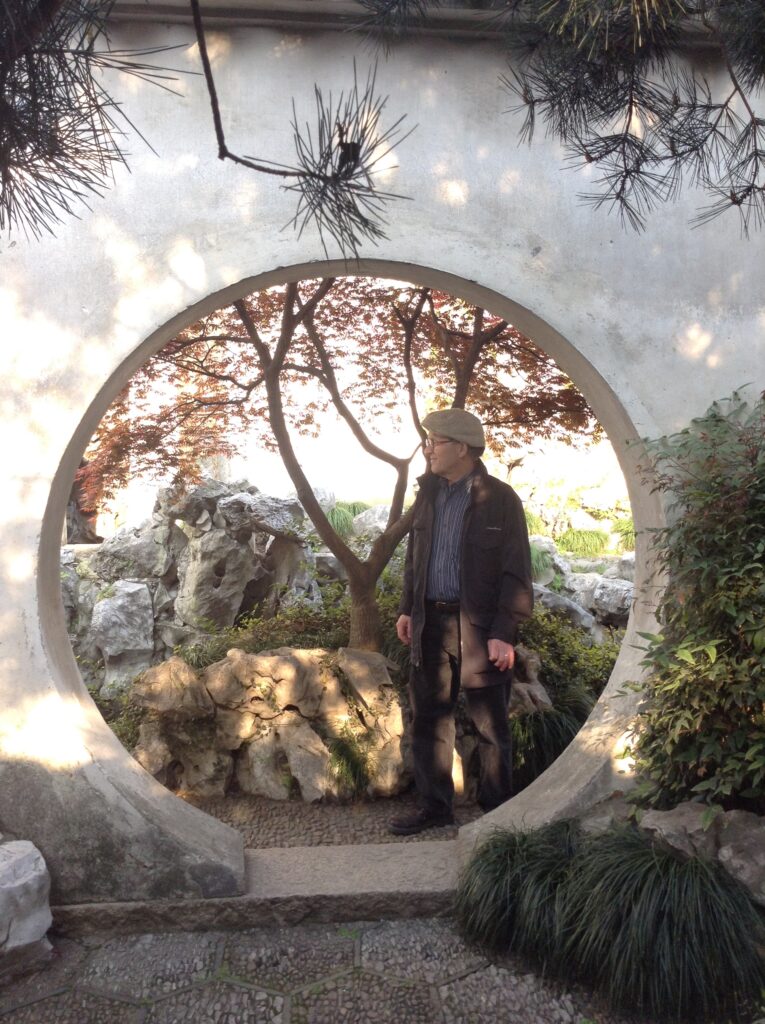Phil Freshman, who I met in 1970, died yesterday.
There are so many good memories, and so many stories I could tell.
I first saw his name in a by-line on an article in the UC Santa Cruz student newspaper in the fall of 1969. The article was about freshman orientation; I thought the by-line was a pseudonym. A few months later this guy stuck his hand out and said, “I’m Phil Freshman.” I started laughing.
In 1981 I was living in Oregon when my little brother got married in our home town in San Diego. Wanting to surprise him, I told him I wouldn’t be able to make it, then got into my car and started driving south. In L.A. I stopped to pick up Phil, who was at home with his parents in Reseda. We arrived in time for the wedding, and Phil spent the entire afternoon talking with everyone at the reception. He had a way of meeting people I had known for years and finding out more about them in ten minutes than I ever knew. As the sun was setting and we started back north, I said, “So . . . what do you think?” There was a pause, then a sigh; then he shook his head. “I thought people in L.A. were superficial,” he said.
His original idea of a career in journalism turned instead into a career as a copy-editor who specialized in catalogues and other publications by art museums. Meticulous and stubborn (and almost always right), he was invariably embroiled in disagreements. In 1982, while working at the Los Angeles County Museum of Art (LACMA), two of his colleagues wanted to dispense with the hyphen in the name of their department. His memo to the boss on this topic is reproduced here for posterity. (“I was just trying to make people laugh, convince them via humor,” he said later. The hyphen in “Twentieth-Century Art” was retained, but no one seems to have laughed.)
To: Earl A. Powell III
From: Phil Freshman
Subject: Twentieth-Century HyphensAs you know, a storm has lately been rattling teacups in the upstairs offices over what would seem to be an innocuous grammatical point. Maurice Tuchman and Stephanie Barron evidently abhor the presence of a hyphen when it is used to hook up the words Twentieth and Century when they appear adjectivally prior to the word Art. More specifically, the curators, formerly of the Department of Modern Art (formerly the Modern and Contemporary Art Department) are adamantly opposed to having their newly renamed department publicly known as the Department of Twentieth hyphen Century Art. I’m told they see the hyphen, in this location at least, as a blemish, an excrescence.
I confess that when I first heard of their assault on our language’s unsung little intelligibility-maker, my professional instinct was to rush unquestioningly to its defense. After all, wouldn’t our bearings be more difficult to find if we didn’t have the adjectivally employed hyphen to tell us we were about to see “sixty-odd works of art” rather than “sixty odd ones”? And how embarrassed we might feel if we were left, hyphenless, to divine the best way to approach an “ill favored woman”.
More angrily, and pointedly, I could have arisen, stuck an index finger down onto any properly punctuated book, newspaper, or magazine page where the subject of 15th-century poetry, 19th-century sculpture, or 20th-century anarchy was treated and then, folding my arms, let my case rest.
However, being a student who knows the language has a way of changing, sometimes radically, before our very eyes, and being an employee of an American museum in a time when more and more of those institutions’ modern art departments are adopting this century’s name for their very own, I decided to do a bit of digging. I called four major museums, each of which had, according to the 1981 Official Museum Directory, “20th Century Art” departments. Instead of phoning these museums’ editorial departments and collecting a pile of confirmations for my view, I spoke with members of the departments in question; if they felt as Maurice and Stephanie do, and had gotten their museums to condone the breaking of grammatical code, I wanted to hear from them how they had justified it.
The four museums I called were the Metropolitan in New York, the Museum of Fine Arts in Boston, the Philadelphia Art Museum, and the Art Institute of Chicago.
At the Metropolitan, a Mrs. Rubin, the assistant to one of the associate curators of Twentieth no hyphen Century Art, told me the department had had the name since the ’60s and that no one, certainly no editors, had to her knowledge ever questioned the usage. She said the department refers to itself in all public places hyphenlessly. “But now that you mention it,” she added, “yes, I guess you’re right. I wonder why no one has ever said anything?”
Next I called Boston. “Don’t mention that hyphen!” cried Debbie Emerson, the departmental secretary. “We all think it’s ugly, unsightly.” But does the Museum of Fine Arts use it? “Yes,” she admitted. “Our editors make us. On business cards, in the annual reports, everywhere. But around the office we avoid it like the plague.”
Then it was Philadelphia, where I talked with the curator herself, Ann d’Harnoncourt. “You tell Maurice and Stephanie I’m on their side,” she said. “I just can’t stand that hyphen, and I never use it in any of my letters.” But what about the museum’s official usage? “Well of course it’s correct and the museum includes it in the calendar of events, the annual report, you name it. But God, it’s so unaesthetic!”
Finally, Chicago. Susan Frio, the department’s secretary, was just as hot on the subject as her co-religionists in Boston and Philadelphia. “We despise that hyphen, but what are we going to do? We co-publish the University of Chicago Manual of Style [LACMA’s style bible], and so it would look pretty dumb if we deviated from that. So we make it Department of Twentieth hyphen Century Art consistently.”
What are we to conclude from all this? Seemingly, the law-abiding adjectival hyphen, just trying to do his job in the strife-torn world of modern language, is undergoing a death-dealing hail of abuse by other twentieth-century art departments than our own. However, he has, in most places, managed to survive. I want him to survive here. And so I recommend, consistent with both grammatical practice and the policies of reputable (though embattled) museums, that this museum recognize the legitimacy and necessity of linking Twentieth and Century with a hyphen whenever those two words publicly precede Art.
Naturally, I wouldn’t presume to suggest extending this rule to the private correspondence and paperwork of the Twentieth-Century Art curators, or anybody else. That would indeed be a less-than-reasonable, over-regimented, far-fetched, and even un-American policy.
In 2015 he came to visit me in Suzhou, China, where I had been living and working for a decade. Although we hadn’t seen each other for years, we picked up right where we left off, and Phil was the same curious, gregarious omnivore of new experiences that he had always been. I am so blessed to have known him, and I will miss him, as the saying goes, like salt.




Beautiful-poignant!
Heart-touching
E-
So sorry about the loss of your good friend. Lovely tribute. xo
Eric, thank you for sharing this wonderful story. I have been Phil and Wendy’s neighbor for the past 20+ years. Truly a remarkable man, I will miss him very much.
Thank you, Merrie!
Eric, thanks so much for this. Phil was my friend for about a dozen years, though it felt like we’d known each other forever (he did have that knack, didn’t he?). I was lucky enough to have had a long phone gab with him a couple of weeks before he died, never dreaming that it would be our last conversation. You capture him beautifully here. I miss him a lot.
Thank you, Colleen. We are all so lucky to have known him.
Phil was a wonderful professional colleague and he will be missed!
Eric, thank you for your beautiful essay. You’ve captured both Phil’s wicked sense of humor and his infectious enthusiasm. (He was beyond excited about that trip to China.) Phil was a kind and generous mentor to me when I decided to pursue art editing. Truly one of a kind.
Thank you, Laura! Much appreciated!
Always appreciated Phil’s work, both in and behind the scenes, with the Association of Art Editors, which I have been a proud member of since 2010. Thanks for sharing so much more about him!
Thank you, Beth!
Dear Eric,
I hadn’t known that Phil died until I looked him up a few minutes ago and found your tribute to him. This morning I was reading a copy of Leon Edel’s Henry James A Life. (Damn, I can’t underline the title. Sorry, Phil)
Phil gave it to me back when we worked together at The Walker Art Center. His inscription is and was charming. I feel desolate that I can’t speak with him again, catch up, laugh. Thanks very much for including his memo—perfection.
Ruth
Thank you, Ruth. “Desolate” is the word.
So sad to read that Phil is gone. I worked with him on a book years ago. He was tenacious, and kind. One evening the dinner I was making for friends almost burned because Phil was on the phone with changes that needed to be made to the book. I couldn’t not stay on the phone to hear what he had to say! Fortunately my friend Monica, in my absence, had the good sense to take over cooking.
I’m looking for an editor for a client on a book on his Peace Corps time in Africa. Any suggestions?
Thank you, Nora. I’m not part of the book-editing world, so I can’t help you there. Maybe someone else here will have an idea.